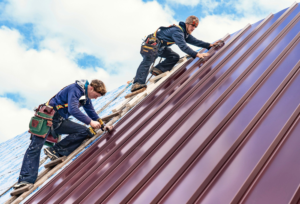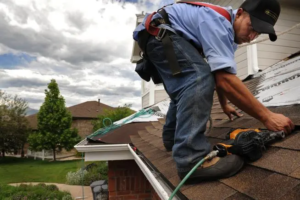Roofing is the outer layer of protection that shields building occupants from harsh weather. It also significantly influences the overall aesthetic of a structure’s design.
From the gently sloping shingles of cozy cottages to the dramatic pitched roofs of European cathedrals, each form and material reflects the needs of specific climates and architectural styles. Contact Erie Roofing now!

Roofing has a practical function of protecting people from the elements, but it also adds to the aesthetic of any building. It’s no wonder that this aspect of architecture has been constantly evolving over the years.
Some of the very earliest roofs were constructed from materials like animal skins, sticks, mud and clay. This is likely because early hunters and gatherers were limited to what they could find in their environment. These crude shelters were designed to protect them from inclement weather and other natural hazards, but they lacked the insulation and protection of modern roofs.
As people gathered in larger groups and moved away from hunter-gathering lifestyles, they started to create permanent shelters. These first roofs were often thatched and consisted of dried vegetation. This was a natural choice because it made the most use of materials found in nature and was a natural material that was insulating and lightweight. It was a durable option, but it was not without its problems because thatch easily rotted and was easily susceptible to fire damage.
Around 735 AD, a major advancement came with the development of the first thatched-tile roofs. These were primarily used in Mediterranean areas, but they later spread to other regions as well. By the middle ages, tile roofs became more common, and by the 19th century, they were widely used.
Copper and lead were popular metals for roofing materials at this time because they offered durability and were relatively easy to work with. However, the advent of sheet iron was one of the key factors that allowed metal roofing to become more popular. This was made possible by Robert Morris, a Revolutionary War financier who was able to develop a method of drawing iron sheets through baths of molten tin and zinc. This process was later perfected and galvanized to protect the metal from rust.
By the 18th century, most settlers preferred to use wood for their roofs because it was available in different varieties across the country (yellow pine in New England, cypress in Florida and cedar everywhere else). By this time, people were starting to treat wood shingles with pine pitch and linseed oil to protect them from the sun and rain that contributed to premature deterioration.
Materials
There are a wide variety of roofing materials available for homeowners, from natural products like thatch and slate to manufactured options such as shingles, tiles and polycarbonate sheeting. Each of these materials is designed to protect a building from weather damage and a number are also available in green designs that help to reduce energy costs. When selecting a roofing material for your home, consult a professional who can explain the benefits and drawbacks of each option.
Asphalt shingle is the most popular type of residential roof covering and comes in many styles and colors. It is very durable and cost effective. Most asphalt shingle roofs are warranted for 20 to 25 years.
Wood shingle is an attractive option for some homes. Cedar and redwood are good choices but may require periodic repairs. Young growth cedar has a limited life expectancy and is more susceptible to insect infestation than older growth. Slate is another high-end roofing material that adds to a home’s value and beauty. It is a natural product that requires skill and experience to install properly. It has a long life expectancy of up to 100 years.
Clay tile roofs are molded from earthen clays into rolled or interlocking shapes and fired for strength and durability. They are a good choice for warm, dry climates and can be left unglazed for a rustic appearance or glazed for color and water resistance. Concrete tile roofs are similar to clay but typically have a longer lifespan and are less expensive.
Flat roofs are challenging to work on and must be installed by a skilled contractor. They can be constructed from a single membrane or layered systems, and are sometimes covered with gravel for drainage. Flat roofs are prone to leaks and often need regular maintenance and repair.
Insulation is an important addition to any roof type. It helps to lower utility bills by reducing heat gain in summer and loss in winter. Professionals can advise on the best insulation for your home and local climate. Many newer roofing materials include features that enhance energy efficiency. These can include reflective shingles, solar panels, air ventilation and other options.
Shapes and Styles
The shape of a roof can tell a lot about the building it covers. It can also add style, utility and value. There are many different types of roof shapes that reflect cultural heritage, environmental adaptation and architectural innovation. From a flat, square structure to the modern Skillion, each design serves a purpose. A gable roof, for example, is simple to build, sheds water and snow quickly and works well with most house designs. A mansard roof, on the other hand, adds a distinct French aesthetic and can be punctuated with dormers for added floor space. The Monitor roof is another type of unique shape that can be used to boost the visibility and ventilation of a home or office.
There are even curved roofs that can be used for entrances and other architectural features.
Installation
When you think of roofing, the first thing that comes to mind is the tangible shield that protects your home from rain and other weather. But the concept of roofing goes much further than just the roof itself. Roofing includes all the processes involved in installing, maintaining, and repairing a roof.
Professional contractors know the proper installation methods for every kind of roof. They also follow strict safety protocols to prevent injuries. Before they start working, they prep the area by covering landscaping with tarps and moving vehicles and other items away from the base of the roof. They also cover any open drains to keep debris from clogging them.
Some common roofing materials include shingles (made of asphalt or wood), metal roofs, and tile roofs. Each type has its pros and cons in terms of durability, longevity, and cost, so choose the one that fits your needs and budget. When choosing a contractor, compare quotes carefully and make sure they include all expected expenses. Also, ask about the contractor’s experience with roofing projects and request references you can contact. This will help you gauge the quality of their work and determine whether they are a good fit for your project.

